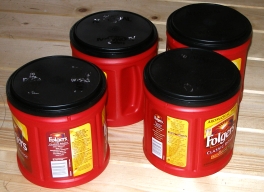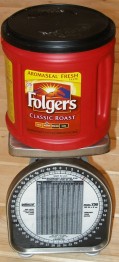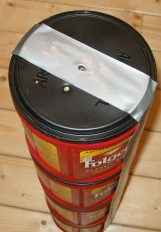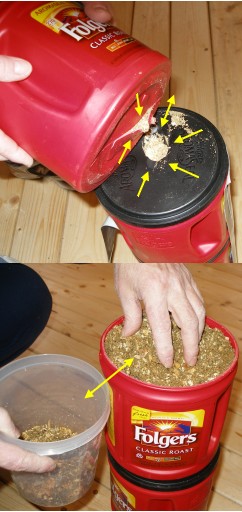 I know ballistic gelatin is impressive. We can shoot holes in Bill Cosby’s finest, watch it wiggle and wobble, and establish just how well a bullet would perform on…boneless, hideless game with innards uniformly near the density of water. Something along the lines of the greater horned African water balloon.
I know ballistic gelatin is impressive. We can shoot holes in Bill Cosby’s finest, watch it wiggle and wobble, and establish just how well a bullet would perform on…boneless, hideless game with innards uniformly near the density of water. Something along the lines of the greater horned African water balloon.
Besides its dubious value in assessing bullet performance in living things, gelatin is not cheap, it deteriorates like any other organic substance and it is not reusable. The supplier recommendation, the folks who make money selling the stuff, suggest a maximum of five shots into a primary 6″x6″x16″ block. At $25 – $30 per block, with at least a couple of blocks typically required, one primary and one back up. That’s $6 – $12 per bullet tested. The synthetic reusable versions like Bullet Tube go for $80 a pop; one tube required to examine wound channels, two required for bullet recovery, more when moving up to cartridges that exceed the 338 Winchester Magnum in power. Perma Gel, another synthetic, is $169 for a 5 1/2″x11″x17″ reusable block. Some synthetics further the myth of product usefulness by leaving a gaping wound channel that doesn’t close, claiming it is “freezing” the effect of the bullet on tissue…sort of like in the old Saturday morning cartoons and those Elmer Fudd induced paper punch like bullet holes.
When looking for alternatives, I got to thinking about a study that was published in 1983 by the Department of Agriculture, specifically, a paper written by William R. Meehan and John F. Thilenius, titled ” Safety in bear country: protective measures and bullet performance at short range”. At the time of the study Meehan was a fisheries project leader, Thilenius was a research wildlife biologist, both working for the U.S. Forestry Department. The authors were researching the selection of an ideal combination of firearm and cartridge that would best protect rangers working in bear country, where the danger of a short range attack by a bear was a very real occupational hazard. The basis for the test medium and set up used in this research was a book written by Bob Hagel, Game loads and practical ballistics for the American hunter. New York, NY: Alfred A. Knopf; 1978. Bob Hagel, was a gun writer and accomplished big game hunter whose work was built on a solid foundation of empirical data. For those of you who may be interested in reading some of this original material, the Department of Agriculture paper can easily be found through Internet search. Hagel’s book is out of print, but there are lots of copies still available from used book sources for a few dollars. The conclusion of all was that bullets tested under the defined process closely approximated the appearance of similar bullets pulled from game. I liked the concept and I bought into the use of the defined medium, but I thought I would put a slight twist on the set up.
Building a…different mousetrap

I know these look like empty plastic containers, but they are actually a tool for bullet impact analysis with the capacity to handle a 460 Weatherby Magnum. The referenced study, utilizing a medium mixture of moist 50% sawdust and 50% silt, established maximum penetration of cartridges tested at 19″ (458 Winchester Magnum) with the heaviest magnum handgun cartridges (44 RemingtonMagnum) closer to 16″. The more typical handgun rounds penetrated less than 12″. Each Folgers container measures 6″x6″ inches so four of them in tandem would handle just about anything. Not as a backstop, just a crude method of measuring expansion and penetration.
 The study’s use of the words “moist” and “silt” lack specificity, so duplication of the study was not straight forward. Additionally, there was a lack of detailed cartridge load information which prevented me from correlating the results of my tests with a large number of those indicated in the study. Still, I was able to compare enough of them, like the 375 H&H, 7mm Remington Magnum, 44 Remington Magnum, and 45 Colt to feel I was very close. The approach might not get a Steven Hawking’s seal of approval but, backed up with a good deal of empirical data, it was more scientifically credible than an Al Gore symposium on global warming.
The study’s use of the words “moist” and “silt” lack specificity, so duplication of the study was not straight forward. Additionally, there was a lack of detailed cartridge load information which prevented me from correlating the results of my tests with a large number of those indicated in the study. Still, I was able to compare enough of them, like the 375 H&H, 7mm Remington Magnum, 44 Remington Magnum, and 45 Colt to feel I was very close. The approach might not get a Steven Hawking’s seal of approval but, backed up with a good deal of empirical data, it was more scientifically credible than an Al Gore symposium on global warming.
 I tried a number of different combinations of ingredients, making sure they were mixed thoroughly for uniform density, then weighed filled containers and calculated density for reference. 60% by volume of sawdust stored in 70% relative humidity and 40% high granite content silt seemed to do the trick. At 4.5 lbs per container, tamped, but not compressed contents, the canister density was 0.496 ounces per cubic inch. Organic ballistic gelatin is 0.556 and artificial ballistic test medium is 0.495. For context, the density of wet sand is 1.111 and water is 0.590. Subjected to the ballistic gelatin calibration test, an air rifle launched 0.177″ BB at 600 fps, penetration to 2 1/2″ – 3″ which indicates a little more resistance than 3″ – 3 3/4″ anticipated penetration for properly prepared gelatin.
I tried a number of different combinations of ingredients, making sure they were mixed thoroughly for uniform density, then weighed filled containers and calculated density for reference. 60% by volume of sawdust stored in 70% relative humidity and 40% high granite content silt seemed to do the trick. At 4.5 lbs per container, tamped, but not compressed contents, the canister density was 0.496 ounces per cubic inch. Organic ballistic gelatin is 0.556 and artificial ballistic test medium is 0.495. For context, the density of wet sand is 1.111 and water is 0.590. Subjected to the ballistic gelatin calibration test, an air rifle launched 0.177″ BB at 600 fps, penetration to 2 1/2″ – 3″ which indicates a little more resistance than 3″ – 3 3/4″ anticipated penetration for properly prepared gelatin.
I believe the greater penetrating resistance of the sawdust – silt mixture with lower density is the result of the medium’s less uniform consistency…or possibly the reflectivity of bright red containers. Yes, I know that makes no sense, but it’s all part of making putting sawdust and dirt in a bucket and shooting it sound scientific. I actually just wanted readers to know that I did spend some time assessing and analyzing the method and the results rather than just blindly accepting the vague premise of the study…which was an acceptance of the vague premise of the Hagel book. If that isn’t enough for my work to win your respect, please remember that my work is based on a study written by people who didn’t want to be eaten by a bear.
Is this going anywhere?
In addition to the fact bullets recovered from the sawdust – silt medium look a lot like the ones I have recovered from game over the years, my medium cost $2 per 100 lbs of sawdust from a local saw mill and the dirt was free. Both ingredients are reusable and this quantity of sawdust will make enough mix to fill 40 – 45 containers. The cost of the Folgers containers is limited to the health risk of drinking coffee and listening to my wife ask me, again, to get the empty containers out of her neat, orderly and clean kitchen.

The containers do have molded in finger depressions that protrude slightly into the container, so indexing these from one to the other maximizes the open shoot through areas. The containers are molded for stacking so they pretty much lock together and a single wrap of duct tape will keep them in alignment.

Since I was shooting in Maine’s version of Spring; snow and ice with freezing rain coming down, I slipped the four container assembly inside of a 12″ diameter Sona tube for longitudinal support and laid the tube on a snow bank. The number of shots that could be taken within any given session was mostly limited to the number of bullets I knew I could positively identify when I pulled from the medium. A cupped heel, brass jacketed bullet and full metal jacket bullet would be easy to identify where two Gold Dot bullets shot at different velocities might not.
Bullet deflection was not a problem at any time, so there were no holes out the side of the containers, or a need to climb trees to retrieve valuable bullet data. I used four containers for all tests, taping over holes after each session and rotating them front to rear. With enough duct tape, qualifying thirty bullets or so was not a problem with a set of four. More containers would have required drinking more coffee.
Ferreting for results
 Checking results is easy. You just remove the duct tape and tip containers until you stop seeing bullet holes. Then you pop off the top of the can where the holes go in, but don’t come out and start excavating away an half inch of material at a time until each bullet is uncovered. When bullet is found you 6″ for each container that was penetrated, then whatever depth in the open container the bullet was uncovered. It is important not to scoop medium out of the container as this could mask a significant variation in penetration depth.
Checking results is easy. You just remove the duct tape and tip containers until you stop seeing bullet holes. Then you pop off the top of the can where the holes go in, but don’t come out and start excavating away an half inch of material at a time until each bullet is uncovered. When bullet is found you 6″ for each container that was penetrated, then whatever depth in the open container the bullet was uncovered. It is important not to scoop medium out of the container as this could mask a significant variation in penetration depth.
Some things that became obvious from this down and dirty test method – The various bullet’s performance or lack of performance had nothing to do with bullets being loaded outside of their design intended impact velocity. The gun and loads delivered the required velocity despite the test gun’s short barrel. As an example, a Hornady #35571 124 grain HP/XTP has an impact velocity spec of 850-1350 fps. This is defined by Hornady on the slip sheets included in bullet boxes as the velocity range for maximum penetration and expansion. However, the bullet was not a great performer at 975 fps, nor was it stellar at 1200+ fps. In fact, these types of results will be the basis for me reevaluating my 357 SIG loads because the several hundred FPS increase over the 9mm Luger may not correct the poor expansion of some of these bullets. I also learned I can back off on my 9mm ++P++ loading. Where three specific bullets performed exceptionally well, a velocity variation of as much as 200 fps had no perceptible impact on bullet expansion or penetration. A lighter load would bring the benefit of additional control for accuracy as well as firearm reliability.
Is there a point to all of this gibberish?
 When I began this little pulp fiction, I was working on a short barrel gun 9mm project that needed better qualification and quantification than just velocity, trajectory and KE. The bullets pictured below are a solid indication as to why that is true.
When I began this little pulp fiction, I was working on a short barrel gun 9mm project that needed better qualification and quantification than just velocity, trajectory and KE. The bullets pictured below are a solid indication as to why that is true.
There are three bullets I would consider for self defense against a human attacker, there are three bullets I would carry for self defense against animals. All are different and the two groups are separated by degree of penetration, not so much the degree of expansion. I would have little use for the remaining 6 outside of target practice.

| # | Manufacturer | Weight Grains |
MV fps |
Retained Weight |
Expanded Diameter “ |
Penetration “ |
| 1 | Nosler | 115 | 1237 | 114.9 | 0.370 | 12 |
| 2 | Sierra | 115 | 1191 | 114.8 | 0.460 | 12 |
| 3 | Speer | 115 | 1260 | 110.9 | 0.480 | 10 |
| 4 | Winchester | 115 | 1236 | 114.0 | 0.636 | 6 |
| 5 | Rem GS | 124 | 1219 | 121.4 | 0.602 | 6 |
| 6 | Hornady | 124 | 1098 | 120.1 | 0.501 | 7 |
| 7 | Rem JHP | 124 | 1199 | 123.1 | 0.562 | 12 |
| 8 | Sierra | 125 | 1035 | 125.0 | 0.635 | 5 |
| 9 | Rem JHP | 147 | 958 | 147.0 | 0.355 | 10 |
| 10 | Hornady | 147 | 985 | 147.0 | 0.356 | 14 |
| 11 | Speer | 147 | 1013 | 147.0 | 0.356 | 11 |
| 12 | Factory UMC | 124 | 1006 | 115 | 0.357 | 8 |
| Impact 10′ from muzzle | ||||||

The best overall performing bullet was the 124 grain Remington Golden Saber. For the purpose of self defense there is appropriate penetration without over penetration. The formed pattern on the nose and composition of brass jacket and core are responsible for what I could only label as ideal controlled and uniform expansion. The bullets are accurate, they feed incredibly well in the little RAMI and with reduced bearing surface they require a lighter charge to achieve the same velocity as a more conventional bullet. The fact the GS is an 11 cent bullet doesn’t hurt either. I do not believe I will be buying more Nosler 115 grain bullets again any time soon. Remington 124 grain JHP bulk bullets may make for good loads when I am out and around in nearby wooded areas and I am more concerned with misbehaving wildlife with teeth where a bullet that penetrates deeper might be more useful.
Summary
I am not suggesting this test method can replace empirical field data that has been carefully gathered and recorded. Nor do I believe this inexpensive and easy test can displace a truly scientific assessment of bullet performance. I would say it is as valid as non-professional ballistic gelatin testing and synthetic gel for assessing a bullet’s expansion and penetration characteristics. The fact the sawdust medium is an inexpensive approach and the plastic containers are so easy to set up and recover bullets means testing can be applied routinely along with velocity, accuracy and reliability assessment to improve the quality and suitability of handloads.

Email Notification